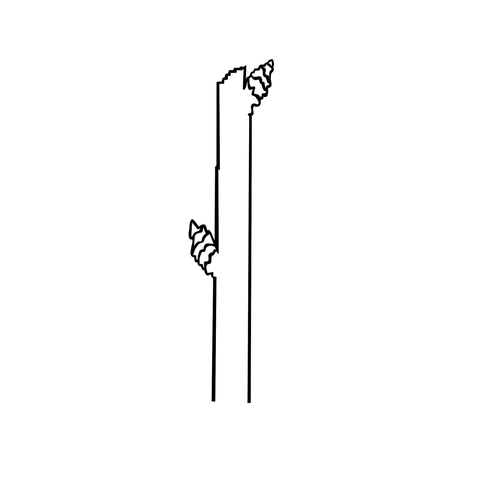Knowledgebase
Zelkova Tree #664738
Asked July 15, 2020, 9:19 PM EDT
Montgomery County Pennsylvania
Expert Response
Jeanne
Pruning should be done in fall, and Japanese zelkova will require some pruning to develop a strong structure. The main branches should spaced along a single trunk, so they develop a secure hold on the trunk. Branches should remain less than 1/2 the diameter of the trunk to maintain a strong form. Here are tips on pruning from the University of Minnesota:
The right tools make pruning easier and help you do a good job. Keeping tools well-maintained and sharp will improve their performance. There are many tools for pruning, but the following will probably suffice for most applications:
- A good pair of pruning shears is probably one of the most important tools. Cuts up to 3/4 inches in diameter may be made with them.
- Lopping shears are similar to pruning shears, but their long handles provide greater leverage needed to cut branches up to 1 1/2 inches in diameter.
- Hedge shears are meant only for pruning hedges, nothing else. They usually cut succulent or small stems best.
- Hand saws are very important for cutting branches over 1 inch in diameter. Many types of hand saws are available. Special tri-cut or razor tooth pruning saws cut through larger branches – up to 4 inches in diameter – with ease.
- Pole saws allow for extended reach with a long handle, but they must be used carefully as it is difficult to achieve clean cuts with them.
- Small chain saws are available for use on larger branches. Operators must wear protective clothing and exercise caution when using them. Never use chain saws to reach above your shoulders, or when you are on a ladder.
How to prune trees and shrubs
General pruning guidelines
- Remove diseased, broken or dead branches.
- Remove any downward-growing branches.
- If two limbs are crossed, entangled or otherwise competing, remove one of them completely at its base.
- Remove any limbs along the trunk that are bigger in diameter than the trunk.
- Remove suckers coming up from the roots or low on the trunk.
- Remove vigorous vertical branches, called watersprouts.
- Make pruning cuts close to the branch collar at the base of the limb.
- For larger limbs, start the cut from the underside of the limb to avoid tearing the bark.
- Remove large limbs first, starting with the top of the tree.
- "Thinning" cuts remove entire branches at the branch collar and are usually the recommended type of cut.
- "Heading" cuts remove only part of a branch and encourage vegetation growth below the cut and are not as common.
Leave the pruning of large trees to qualified tree care professionals who have the proper equipment. Consider the natural form of large trees whenever possible. Most hardwood trees have rounded crowns that lack a strong leader and may have many lateral branches.
Issues to watch for when pruning trees
The most common types of tree pruning are:
- Crown thinning – selectively removing branches on young trees throughout the crown. This promotes better form and health by increasing light penetration and air movement. Strong emphasis is on removing weak branches. (Don't overdo it on mature trees.)
- Crown raising – removing lower branches on developing or mature trees to allow more clearance above lawns, sidewalks, streets, etc.
- Crown reduction – removing larger branches at the top of the tree to reduce its height. When done properly, crown reduction pruning is different from topping because branches are removed immediately above lateral branches, leaving no stubs. Crown reduction is the least desirable pruning practice. It should be done only when absolutely necessary.
- Crown cleaning – the selective removal of dead, dying and diseased wood from the crown.
Proper branch pruning
Cut on a small branch or twig about 1/4 inch above the bud.- To shorten a branch or twig, cut it back to a side branch or make the cut about 1/4 inch above the bud.
- Always prune above a bud facing the outside of a plant to force the new branch to grow in that direction.
Pruning large branches
To remove large branches, three or four cuts will be necessary to avoid tearing the bark.
- Make the first cut on the underside of the branch about 18 inches from the trunk.
- Undercut one-third to one-half way through the branch.
- Make the second cut an inch further out on the branch; cut until the branch breaks free.Use multiple cuts to remove large branches

Before making the final cut severing a branch from the main stem, identify the branch collar.
- The branch collar grows from the stem tissue around the base of the branch.
- Make pruning cuts so that only branch tissue (wood on the branch side of the collar) is removed.
- Be careful to prune just beyond the branch collar, but DON'T leave a stub.
- If the branch collar is left intact after pruning, the wound will seal more effectively and stem tissue probably will not decay.
The third cut may be made by cutting down through the branch, severing it. If, during removal, there is a possibility of tearing the bark on the branch underside, make an undercut first and then saw through the branch.
Wound dressing is not normally needed on pruning cuts. However, if wounds need to be covered to prevent insect transmission of certain diseases such as oak wilt, use latex rather than oil-based paint.


